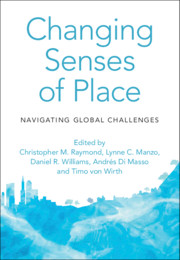Book contents
- Changing Senses of Place
- Changing Senses of Place
- Copyright page
- Dedication
- Contents
- Contributors
- Foreword
- Preface
- Acknowledgements
- Introduction
- Part I Climate Change and Ecological Regime Shifts
- Part II Migration, Mobility and Belonging
- Part III Renewable Energy Transitions
- Part IV Nationalism and Competing Territorial Claims
- Part V Urban Change
- 16 Uncovering Competing Senses of Place in a Context of Rapid Urban Change
- 17 Gentrification and the Creative Destruction of Sense of Place
- 18 Looking at the Urban Invisibles
- Part VI Technological and Legal Transformations
- Part VII Design and Planning Strategies for Changing Senses of Place
- Part VIII Conclusion
- Index
- References
17 - Gentrification and the Creative Destruction of Sense of Place
A Psychosocial Exploration of Urban Transformations in Barcelona
from Part V - Urban Change
Published online by Cambridge University Press: 15 July 2021
- Changing Senses of Place
- Changing Senses of Place
- Copyright page
- Dedication
- Contents
- Contributors
- Foreword
- Preface
- Acknowledgements
- Introduction
- Part I Climate Change and Ecological Regime Shifts
- Part II Migration, Mobility and Belonging
- Part III Renewable Energy Transitions
- Part IV Nationalism and Competing Territorial Claims
- Part V Urban Change
- 16 Uncovering Competing Senses of Place in a Context of Rapid Urban Change
- 17 Gentrification and the Creative Destruction of Sense of Place
- 18 Looking at the Urban Invisibles
- Part VI Technological and Legal Transformations
- Part VII Design and Planning Strategies for Changing Senses of Place
- Part VIII Conclusion
- Index
- References
Summary
Gentrification has become a widespread form of urban transformation during the last decades. While gentrification has been vastly theorised and studied from the point of view of its economic, sociological, cultural or geographical underpinnings, the psychosocial implications of gentrification have been seldom explored. In this chapter, we argue that changing senses of place implicated in gentrification processes can be interpreted not as a mere, even less neutral, effect of capitalist logics of creative destruction of the city, but as one of its main subjective catalysers. Based on the empirical analysis of a study conducted in the neighbourhood of Gràcia (Barcelona, Spain), we discuss the symbolic mechanisms that renew senses of place, transforming them while re-creating them, to channel, re-produce and capture place-based profitable value, i.e. the creative destruction of senses of place. The study advances empirically based knowledge on the ‘semiocapitalist’ processes that reshape sense of place by capitalising on place-related meanings, affect, desire and identification with the urban symbolic environment.
- Type
- Chapter
- Information
- Changing Senses of PlaceNavigating Global Challenges, pp. 221 - 233Publisher: Cambridge University PressPrint publication year: 2021
References
- 3
- Cited by



